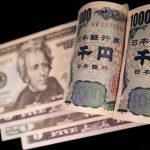
SINGAPORE (Reuters) -Japan’s yen currency fell sharply on Tuesday after the central bank ended its negative interest rate policy in a monumental but highly anticipated decision, while the Australian dollar also slid after domestic rates were kept steady.
In a historic shift from decades of massive monetary stimulus, the Bank of Japan (BOJ) ended eight years of negative interest rates and other remnants of unorthodox policy at the conclusion of a two-day monetary policy meeting.
Still, the yen tumbled 0.8% and weakened past the level of 150 to the dollar after the news, as most investors had already priced a pivot in.
The yen last stood at 150.39 to the dollar. Against the euro, the Japanese currency similarly slid more than 0.7% to bottom at 163.425, its weakest level in three weeks.
“It’s a classic ‘Buy the rumour, sell the fact.’ I don’t think the BOJ was going for the shock-and-awe approach this time,” said Bart Wakabayashi, Tokyo branch manager at State Street (NYSE:STT).
With Japan’s first interest rate hike in 17 years, the central bank said it would guide the overnight call rate – its new policy rate – in a range of zero to 0.1% adding that it expected “accommodative financial conditions” to be maintained for the time being.
That is likely to keep pressure on the yen, as interest rate differentials between Japan and the United States remain stark.
“Anytime the Fed and the BOJ are moving policy settings at about the same time, it’s always the Fed that rules and dominates the price action, even in dollar/yen,” said Gareth Berry, Macquarie’s FX and rates strategist.
“So the BOJ’s decisions generally are, as far as the yen is concerned, a matter of secondary importance.”
RATES OUTLOOK
Down under, the Australian dollar similarly fell after the Reserve Bank of Australia (RBA) left rates unchanged on Tuesday, as expected, but tempered its tightening bias.
The antipodean currency slid 0.7% to a roughly two-week low of $0.6515, dragging the New Zealand dollar with it, as the kiwi fell more than 0.5% to $0.6050.
“We view the RBA as having softened, but not dropped altogether, its tightening bias,” said Adam Boyton, head of Australian economics at ANZ.
“Either way, our own views remain unchanged on account of this RBA meeting. We continue to favour November for the start of a mild easing cycle.”
Elsewhere, a broadly stronger dollar pushed the euro and sterling to two-week lows.
The euro bottomed at $1.08625, while the British pound fell about 0.2% to $1.2703.
The greenback’s rebound follows a recent run of resilient U.S. economic data pointing to still-sticky inflation, leading investors to adjust expectations for the pace and scale of Federal Reserve rate cuts this year.
That comes ahead of Wednesday’s Fed’s policy decision, which will be scrutinised for clues to how soon the central bank could start easing rates.
“We expect the FOMC to continue to show a three-cut baseline for 2024 at its March meeting and have lowered our own forecast to three cuts versus four previously in 2024,” Goldman Sachs chief U.S. economist David Mericle said in a note.
Against a basket of currencies, the dollar scaled a two-week top of 103.82.
To read the full article, Click Here

